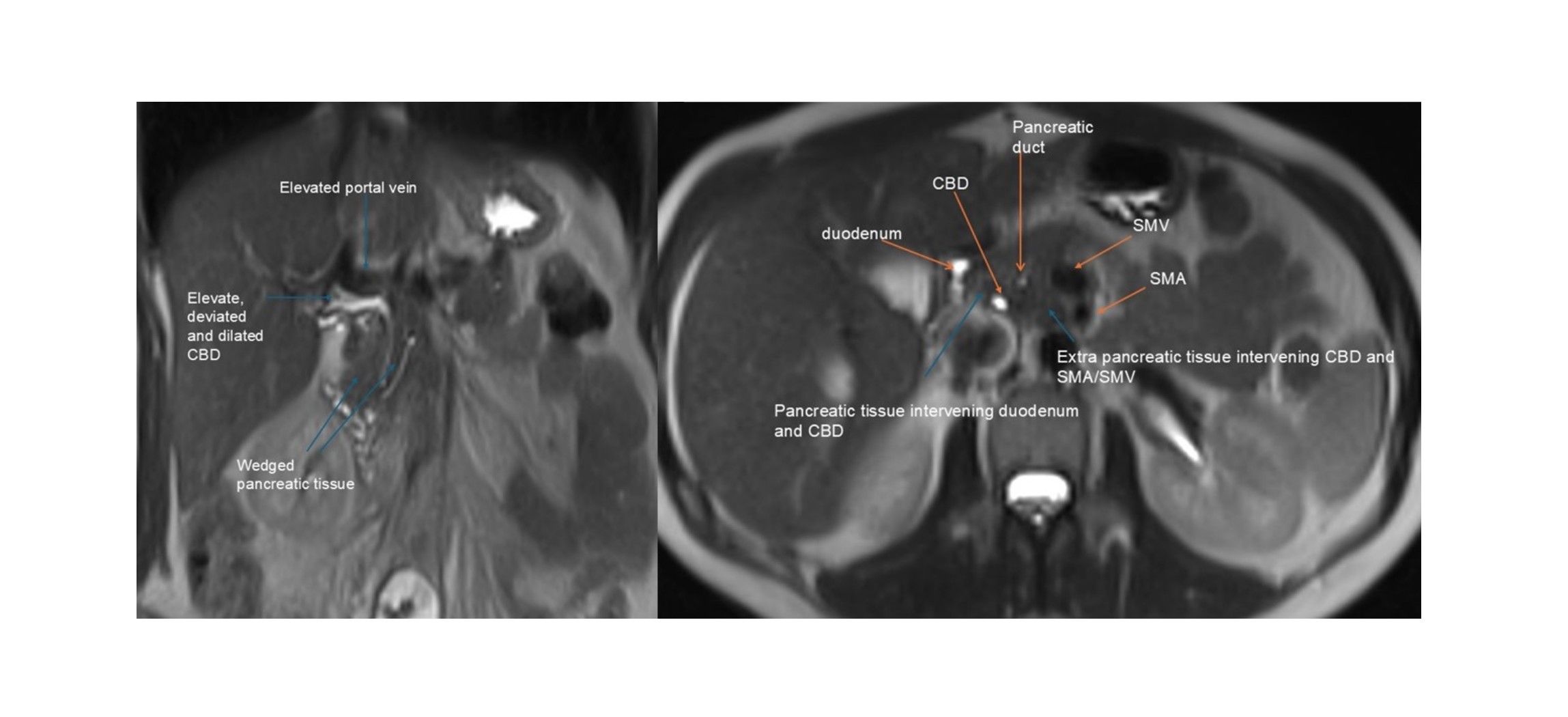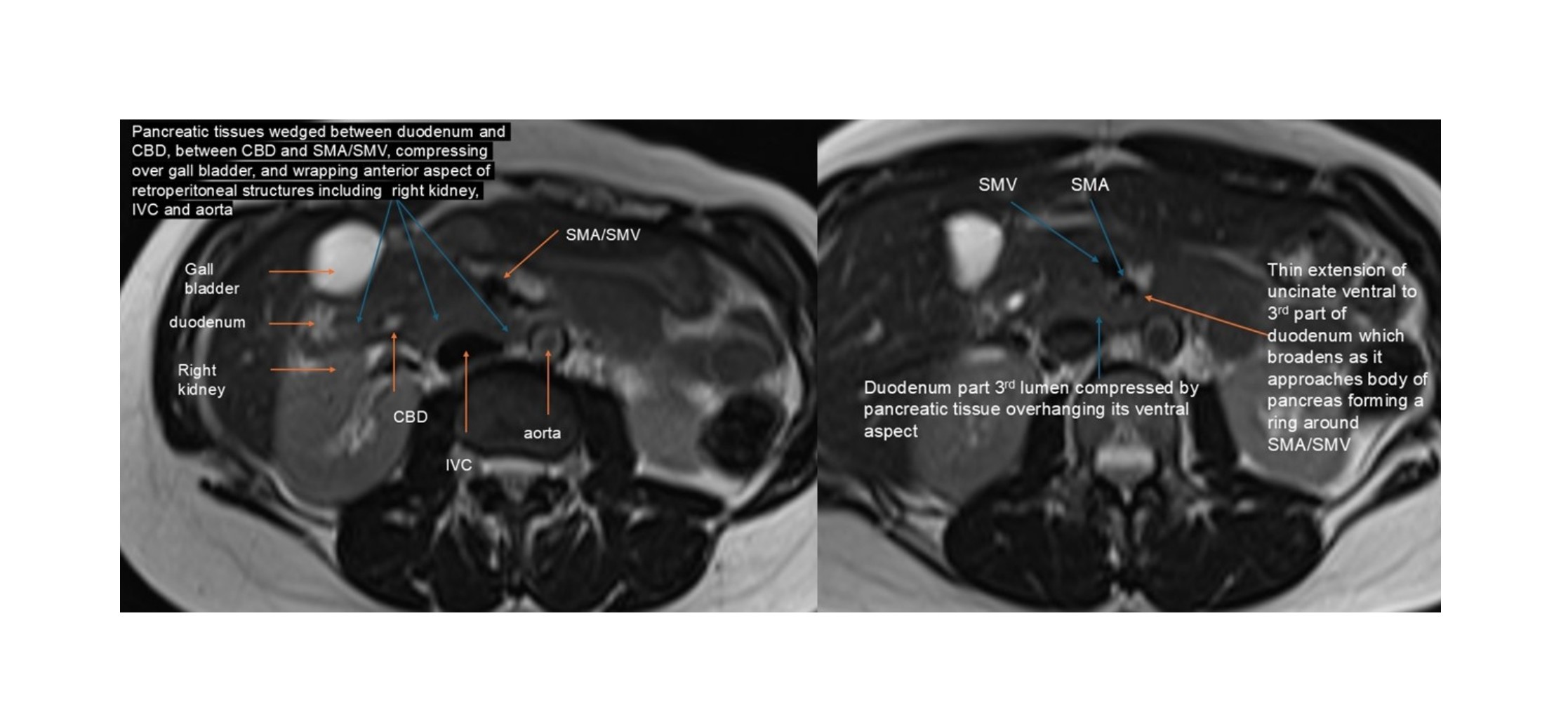Tuesday Poster Session
Category: Biliary/Pancreas
P4529 - Extensive Enlargement of the Pancreatic Head and Uncinate Process: An Overlooked Anatomical Variant With Clinical Implications
Tuesday, October 28, 2025
10:30 AM - 4:00 PM PDT
Location: Exhibit Hall
- MH
Madiha Haseeb, MBBS
SUNY Downstate Health Sciences University
Brooklyn, NY
Presenting Author(s)
Neha Boski, MD, FRCR1, Madiha Haseeb, MBBS2, Rohan Raj, MBBS3, Mahendra Kumar, MBBS4, Parvinder Kaur, MD5, Kausar Bano, MBBS6
1Apollo Radiology International, Hyderabad, India, Hyderabad, Telangana, India; 2SUNY Downstate Health Sciences University, Brooklyn, NY; 3Memorial Hospital at Gulfport, Gulfport, MS; 4Sardar Patel Medical College, Bikaner, India, Bikaner, Rajasthan, India; 5Crimean State Medical University named after Sal Georgivsky Simferopol, Ukraine, Nawanshahr, Punjab, India; 6Katihar Medical College Hospital, Katihar, Bihar, India
Introduction: Extensive enlargement of the pancreatic head and the uncinate process is an exceedingly rare and underrecognized anatomical variant, with rare documentation in current medical literature. It is hypothesized to result from excessive fusion or disproportionate growth of the ventral and dorsal pancreatic buds during embryogenesis. Such extensions may encase or displace adjacent retroperitoneal organs and neurovascular structures, mimicking mass lesions or creating potential sites for internal herniation. We present two radiologically confirmed cases of this entity discovered incidentally in asymptomatic individuals undergoing pancreatic screening.
Case Description/
Methods: Two unrelated, asymptomatic middle-aged women with a family history of pancreatic cancer underwent screening abdominal imaging. Cross-sectional imaging revealed extensive enlargement of the pancreatic head and uncinate process in both patients. The pancreatic tissue wrapped around several retroperitoneal structures including the anterior walls of the second and third parts of the duodenum (resulting in C-loop widening and mild luminal narrowing), the common bile duct, anterior aortic surface, inferior vena cava, superior mesenteric vessels, and extended up to the right renal upper pole. Importantly, the enlarged tissue demonstrated isointense on all MRI sequences, no abnormal contrast enhancement, and homogeneity with the rest of the pancreatic parenchyma. One case showed stable imaging findings over a 5-year interval, favoring a benign, nonneoplastic anatomical variant.
Discussion: These cases raise important considerations regarding the embryological origins, clinical implications, and diagnostic challenges posed by this rare pancreatic variant. Recognizing such anatomical variants is critical for radiologists to avoid false-positive interpretations, for gastroenterologists and pancreaticobiliary specialists to consider when evaluating duodenal compression or atypical abdominal symptoms, and for surgeons or interventionalists to avoid iatrogenic injury. As current literature remains limited, these cases highlight the need for further research into the incidence, clinical course, and long-term implications of extensive pancreatic head and uncinate process enlargement.

Figure: Figure 1: Case 1: Coronal (left) and axial (right) MRI images showing enlarged pancreatic tissue extending between the duodenum and common bile duct (CBD), causing medial deviation and dilatation of the CBD, along with elevation of the portal vein. The axial image demonstrates tissue encasing retroperitoneal structures, narrowing the duodenum, and displacing the SMA/SMV, IVC, and aorta.

Figure: Figure 2: Case 2: Axial MRI images reveal prominent enlargement of the pancreatic head and uncinate process, wrapping around the duodenum, CBD, IVC, aorta, and right kidney. A thin extension partially encircles the superior mesenteric vessels. Note smooth indentation on the gallbladder and luminal narrowing of the third part of the duodenum.
Disclosures:
Neha Boski indicated no relevant financial relationships.
Madiha Haseeb indicated no relevant financial relationships.
Rohan Raj indicated no relevant financial relationships.
Mahendra Kumar indicated no relevant financial relationships.
Parvinder Kaur indicated no relevant financial relationships.
Kausar Bano indicated no relevant financial relationships.
Neha Boski, MD, FRCR1, Madiha Haseeb, MBBS2, Rohan Raj, MBBS3, Mahendra Kumar, MBBS4, Parvinder Kaur, MD5, Kausar Bano, MBBS6. P4529 - Extensive Enlargement of the Pancreatic Head and Uncinate Process: An Overlooked Anatomical Variant With Clinical Implications, ACG 2025 Annual Scientific Meeting Abstracts. Phoenix, AZ: American College of Gastroenterology.
1Apollo Radiology International, Hyderabad, India, Hyderabad, Telangana, India; 2SUNY Downstate Health Sciences University, Brooklyn, NY; 3Memorial Hospital at Gulfport, Gulfport, MS; 4Sardar Patel Medical College, Bikaner, India, Bikaner, Rajasthan, India; 5Crimean State Medical University named after Sal Georgivsky Simferopol, Ukraine, Nawanshahr, Punjab, India; 6Katihar Medical College Hospital, Katihar, Bihar, India
Introduction: Extensive enlargement of the pancreatic head and the uncinate process is an exceedingly rare and underrecognized anatomical variant, with rare documentation in current medical literature. It is hypothesized to result from excessive fusion or disproportionate growth of the ventral and dorsal pancreatic buds during embryogenesis. Such extensions may encase or displace adjacent retroperitoneal organs and neurovascular structures, mimicking mass lesions or creating potential sites for internal herniation. We present two radiologically confirmed cases of this entity discovered incidentally in asymptomatic individuals undergoing pancreatic screening.
Case Description/
Methods: Two unrelated, asymptomatic middle-aged women with a family history of pancreatic cancer underwent screening abdominal imaging. Cross-sectional imaging revealed extensive enlargement of the pancreatic head and uncinate process in both patients. The pancreatic tissue wrapped around several retroperitoneal structures including the anterior walls of the second and third parts of the duodenum (resulting in C-loop widening and mild luminal narrowing), the common bile duct, anterior aortic surface, inferior vena cava, superior mesenteric vessels, and extended up to the right renal upper pole. Importantly, the enlarged tissue demonstrated isointense on all MRI sequences, no abnormal contrast enhancement, and homogeneity with the rest of the pancreatic parenchyma. One case showed stable imaging findings over a 5-year interval, favoring a benign, nonneoplastic anatomical variant.
Discussion: These cases raise important considerations regarding the embryological origins, clinical implications, and diagnostic challenges posed by this rare pancreatic variant. Recognizing such anatomical variants is critical for radiologists to avoid false-positive interpretations, for gastroenterologists and pancreaticobiliary specialists to consider when evaluating duodenal compression or atypical abdominal symptoms, and for surgeons or interventionalists to avoid iatrogenic injury. As current literature remains limited, these cases highlight the need for further research into the incidence, clinical course, and long-term implications of extensive pancreatic head and uncinate process enlargement.

Figure: Figure 1: Case 1: Coronal (left) and axial (right) MRI images showing enlarged pancreatic tissue extending between the duodenum and common bile duct (CBD), causing medial deviation and dilatation of the CBD, along with elevation of the portal vein. The axial image demonstrates tissue encasing retroperitoneal structures, narrowing the duodenum, and displacing the SMA/SMV, IVC, and aorta.

Figure: Figure 2: Case 2: Axial MRI images reveal prominent enlargement of the pancreatic head and uncinate process, wrapping around the duodenum, CBD, IVC, aorta, and right kidney. A thin extension partially encircles the superior mesenteric vessels. Note smooth indentation on the gallbladder and luminal narrowing of the third part of the duodenum.
Disclosures:
Neha Boski indicated no relevant financial relationships.
Madiha Haseeb indicated no relevant financial relationships.
Rohan Raj indicated no relevant financial relationships.
Mahendra Kumar indicated no relevant financial relationships.
Parvinder Kaur indicated no relevant financial relationships.
Kausar Bano indicated no relevant financial relationships.
Neha Boski, MD, FRCR1, Madiha Haseeb, MBBS2, Rohan Raj, MBBS3, Mahendra Kumar, MBBS4, Parvinder Kaur, MD5, Kausar Bano, MBBS6. P4529 - Extensive Enlargement of the Pancreatic Head and Uncinate Process: An Overlooked Anatomical Variant With Clinical Implications, ACG 2025 Annual Scientific Meeting Abstracts. Phoenix, AZ: American College of Gastroenterology.
